|
Page < 1 2 3 4 5 6 7 8 9 10 11 12 13 14 15 >
Evidence
from Archaeology
Soon after the discovery of
Mohenjo-daro and Harappa, their remote antiquity signaled the start
of a virtual comedy of errors. The myth of the bloody end of the
Harappan civilization at the hands of the fierce Aryans came from a
man who had directed the Archaeological Survey of India from 1943 to
1948. The most glaring inconsistencies the owners of the said
skeletons were later proved by the great U.S. archaeologist George
F. Dales to have lived in different periods. Moreover,
neither weapons nor any signs of war were found at the supposed
sites of the "mythical massacre," as he called it:
"Where
are the burned fortresses, the arrow heads, weapons, pieces of
armor, the smashed chariots, and bodies of the invaders and
defenders." asked Dales,
who, in 1964 conducted a detailed study of Wheeler's stratigraphy.
"Despite the extensive excavations at the largest Harappan
sites, there is not a single bit of evidence that can be brought
forth as unconditional proof of an armed conquest and the
destruction on the supposed scale of the Aryan invasion." U.S.
anthropologist, K. A. R. Kennedy
showed that the supposed injuries left on the bones of some
skeletons had actually healed well before death. As a result,
"the destruction of the Indus cities by invading tribes of
Aryans, says the U.S. archaeologist Richard
H. Meadow, "has long since been discounted by
serious scholars" (though some of our textbooks still swear by
it ).
Not a single finding in the
Indus-Saraswati
region can be associated with the ingress of an Aryan people (or any
other people, for that matter) - neither pottery nor utensils nor
tools nor weapons nor graves nor any form of art. Oddly,
the "invaders" left no trace of their arrival. J. M.
Kenoyer, who is still pursuing excavations at Harappa:
"There is no
archaeological or biological evidence for invasions or mass
migrations into the Indus valley between the end of the Harappan
phase, about 1900 B.C. and the beginning of the Early Historic
period around 600 B.C. "
Jim G. Shaffer,
another U.S. archaeologist with first-hand experience of Harappan
site:
"Current archaeological data do
not support the existence of an Indo-Aryan or European invasion into
South Asia any time in the pre- or protohistoric periods."
Many Indian archaeologists share
those views. For instance S. R. Rao
" "There is no indication of any invasion of Indus towns
nor is any artefact attributable to the so-called 'invaders.'
Or again, B.
B. Lal: "The supporters of the Aryan-invasion theory
have not been able to cite even a single example where is evidence
of 'invaders.' represented either by weapons of warfare or even of
cultural remains left by them." Similar assertions could be
quoted from other noted archaeologists such as (alphabetically)
Madhav Acharya, R.S. Bisht, Dilip K. Chakrabarti, M.K. Dhavalikar,
S. P. Gupta, Jagat Pati Joshi, V.N. Mishra, A.M. Shastri, K.M.
Srivastava, V. S. Wakankar and others.
Despite this remarkable agreement, a
few historians and archaeologist have opted to stick to the invasion
construct, partly as a facile explaination of the linguistic kinship
between Sanskrit and Indo-European languages, and partly because it
is not easy to demolish a whole structure accepted as gospel truth
for a lifetime. So, to account to its
absence of evidence those scholars have had to tone down the old
invasion, which now becomes a mere "migration" or
"small bands" of Indo-Aryans, in a "series of
waves" confession of failure.
With a touch of irony, J.
F. Jarrige, the French archaeologist who has led
excavations at Mehrgarh, remarks: "Phoenix-like, the theory of
the invaders, preferably Indo-Europeans, always rises from its
ashes."
(source: The Invasion That Never Was
-
By Michel Danino and Sujata
Nahar
***
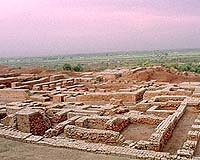 "The
Harappan civilization mysteriously disappeared in 1900 BC, after
almost 2,000 years of continuous existence. Some researchers have
argued that the civilization slowly declined because of changing
trade patterns; others, now mostly
discredited, blamed Aryan invaders from the north. Prasad
and Nur blame earthquakes. Last January, a catastrophic earthquake
struck the southern edge of the former Harappan territory, a coastal
area near the border between India and Pakistan. In 1819, a similar
earthquake raised an 80 to 100-kilometer (50 to 62 mile) ridge of
earth about 20 feet (6 meters), creating an artificial dam known as
the "Allah Bund" (God's Dam). Both earthquakes are
evidence that the Harappan region, though not near a traditional
fault zone, is seismically active." "The
Harappan civilization mysteriously disappeared in 1900 BC, after
almost 2,000 years of continuous existence. Some researchers have
argued that the civilization slowly declined because of changing
trade patterns; others, now mostly
discredited, blamed Aryan invaders from the north. Prasad
and Nur blame earthquakes. Last January, a catastrophic earthquake
struck the southern edge of the former Harappan territory, a coastal
area near the border between India and Pakistan. In 1819, a similar
earthquake raised an 80 to 100-kilometer (50 to 62 mile) ridge of
earth about 20 feet (6 meters), creating an artificial dam known as
the "Allah Bund" (God's Dam). Both earthquakes are
evidence that the Harappan region, though not near a traditional
fault zone, is seismically active."
(source: Ancient
civilizations shaken by quakes, say Stanford scientists
-
Space Daily).
And
now a team of geologists from the Stanford University in California
believes that the real blame probably lies with the massive
earthquakes that struck the region in the past.
Manika Prasad, a research associate in the Rock Physics Laboratory
at Stanford, has catalogued and studied the ancient earthquakes that
shook the Indian sub-continent. He now believes that it was a
massive earthquake that shook the foundations of the Harappan
civilisation, taking it to the brink of extinction.
The Harappan civilisation mysteriously disappeared in 1900 BC, after
almost 2,000 years of existence.
Some
researchers have argued that the civilization slowly declined
because of changing trade patterns; others, now mostly
discredited, blamed Aryan invaders from the north.
(source: Did
quakes make Harappa disappear? NewIndpress.com).
Watch
video - The
Myth of Aryan invasion theory - Part I and Part
II and Part
III and Myth
of Aryan Dravidian Divide and Dwaraka
- A Lost City of Lord Sri Krishna.
***
City
older than Mohenjodaro unearthed
http://www.timesofindia.com/Articleshow.asp?art_id=2140338028
Indian
scientists have made an archaeological find dating back to 7500 BC
suggesting the world's oldest cities came up about 4,000 years
earlier than is currently believed, a top government official said
on Wednesday.
The scientists found pieces of wood, remains of pots, fossil bones
and what appeared like construction material just off the coast of
Surat, Science and Technology Minister Murli Manohar Joshi told a
news conference.
"Some of these artefacts recovered by the NIOT (National
Institute of Ocean Technology) from the site such as the log of wood
date back to 7500 BC, which is indicative of a very ancient culture
in the present Gulf of Cambay, that got submerged
subsequently," Joshi said.
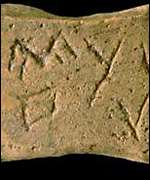 Current belief is that the first cities appeared around 3500 BC in
the valley of Sumer, where Iraq now stands, a statement issued by
the government said.
"We can safely say from the antiquities and the acoustic images
of the geometric structures that there was human activity in the
region more than 9,500 years ago (7500 BC),"
S. N. Rajguru, an independent archaeologist, said.
Current belief is that the first cities appeared around 3500 BC in
the valley of Sumer, where Iraq now stands, a statement issued by
the government said.
"We can safely say from the antiquities and the acoustic images
of the geometric structures that there was human activity in the
region more than 9,500 years ago (7500 BC),"
S. N. Rajguru, an independent archaeologist, said.
The findings, if confirmed, will dislodge the Harappan Civilisation
dating back to 2500 BC as India's oldest civilization.
***
Oldest
Harappan signboard at Kutch township
Meticulous
planning and architectural brilliance in the layout of the city are
the established and striking features of the Harappan civilisation.
Recent excavations at the
small township of Dholavira, in Kutch, Gujarat, have presented to
the world some of the oldest stadiums and
sign board.
One of the stadiums is huge. The
multipurpose structure, with terraced seats for spectators, around
800 feet in length (around 283 metres) can accommodate as many as
10,000 persons. The other stadium is
much smaller in size.
"It is believed that the bigger stadium was used
for a variety of purposes, maybe for makeshift bazaars. This would
be similar to exhibition grounds coming up these days," said
former joint director general of Archeological Survey of India, Dr R
S Bisht who was delivering a special lecture on "Dholavira
revisited' at Panjab University on Wednesday.
Apart from the world's first stadiums, Bisht also
talked about what could be the world's oldest signboard which was
also discovered at the site. The
"signboard", with undecipherable inscriptions of the Indus
valley civilisation, dates back to the 3000 BC to 1500 BC.
It is believed that the stone signboard was hung on a
wooden plank in front of the gate. This could be the oldest
signboard known to us," said Bisht. The excavations began under
Bisht's stewardship in 1990.
The dimensions of the town of
Dholavira (777.1 metres in length and 668.7 meters in width)
establishes that the Harappans had great knowledge of
trigonometry.
They were also mathematical experts as all the
dimensions at the site are based on squares and cubes, he added.
"The site is between the two rivulets, Mansa and Manhar.
Harappans had also built dams to conserve the precious commodity of
water," added Bisht. He also put up a slide show of the remains of the
extensive water reservoirs, castle and roads. He said, "Harappans
never allowed vehicular traffic inside their cities which explains
the condition of their roads which remained as they were for a long
time," he said.
While natural calamities are widely believed to be the
reason for the decline of civilisations, for Dholavira it is
believed that the damage was due to frequent earthquakes. "The
first quake hit the township around 2800 BC, the second around 2500
BC, and the third around 2000 BC," said Bisht.
(source: Oldest
Harappan signboard at Kutch township - http://timesofindia.indiatimes.com/articleshow/505144.cms).
***
Skeletons,
script found at ancient burial site in Tamil Nadu
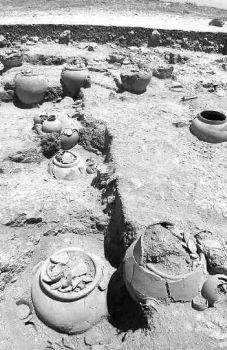 May
25 2004 - An urn containing a human
skull and bones unearthed by the Archaeological Survey of India at
Adhichanallur, near Tirunelveli town in Tamil Nadu. Twelve of
these urns (below) contain human skeletons. Three of them, which
may be 2,800 years old, bear inscriptions that resemble the early
Tamil Brahmi script. May
25 2004 - An urn containing a human
skull and bones unearthed by the Archaeological Survey of India at
Adhichanallur, near Tirunelveli town in Tamil Nadu. Twelve of
these urns (below) contain human skeletons. Three of them, which
may be 2,800 years old, bear inscriptions that resemble the early
Tamil Brahmi script.
In
spectacular finds, the Archaeological Survey of India, Chennai
Circle, has unearthed a dozen 2,800-year-old human skeletons
intact in urns at Adichanallur, 24 km from Tirunelveli in Tamil
Nadu. Three of these urns contain writing resembling
the early Tamil Brahmi script. The dozen urns containing the
skeletons form a part of about 100 fully intact urns unearthed in
various trenches at the site, where excavation is under way. The
urns were found at a depth of two to three metres. The finds may
revolutionise theories about the origin of ancient culture in
Tamil Nadu and the origin of writing in South Asia.
T. Satyamurthy,
Superintending Archaeologist, ASI, Chennai Circle, the director of
excavation at Adichanallur, said: "People generally think
that megalithic culture is the earliest culture in South India,
especially in Tamil Nadu. In our excavation [at Adichanallur], we
have come across a culture earlier than the megalithic
period." The megalithic period in South India ranges from 3rd
century B.C. to 3rd century A.D. At Adichanallur, pottery
belonging to the early historic period, which stretches from 3rd
century B.C. to 3rd century A.D., was found on the upper layers of
the trenches and the urns were found below.
So
the discoveries at Adichanallur may go back to 7th or 8th century
B.C., probably earlier than the Sangam period, Dr. Satyamurthy
said.
(source: Skeletons,
script found at ancient burial site in Tamil Nadu
- hindu.com). For more refer to Vedic
Roots of Early Tamil Culture - By Michel Danino.
***
9,500-Year-Old City Found Underwater
Off India
Discovery in Bay of Cambay Will Force Western Archaeologists to
Rewrite History.
The civilization of Ancient Egypt
occurred in a past so remote that today it seems mystical. The
pyramids and other temples, with their hieroglyphics depicting a
flourishing civilization, have a mysterious, almost magical appeal.
It seems inconceivable that people of an advanced society could have
walked those ancient streets.
Now, it was announced in January, a civilization has been
uncovered that would have appeared just as ancient to the people who
built the pyramids as the pyramids seem to us.
According to marine scientists in India, archaeological remains of
this lost city have been discovered 36 metres (120 feet) underwater
in the Gulf of Cambay off the western coast of India. And carbon
dating says that they are 9,500 years old.
This news completely contradicts the
position of most Western historians and archaeologists, who (because
it did not fit their theories) have always rejected, ignored, or
suppressed evidence of an older view of mankind's existence on
planet Earth. Human civilization is now provably much
more ancient than many have believed.
According to the BBC's Tom Housden, reporting on the Cambay find:
The vast city — which is five miles
long and two miles wide — is believed to predate the oldest known
remains in the subcontinent by more than 5,000 years.
The site was discovered by chance last year by oceanographers from
India's National Institute of Ocean Technology, who were conducting
a survey of pollution.
Using sidescan sonar, which sends a beam of sound waves down to the
bottom of the ocean, they identified huge geometrical structures at
a depth of 120 feet.
Debris recovered from the site — including construction material,
pottery, sections of walls, beads, sculpture, and human bones and
teeth — has been carbon dated and found to be nearly 9,500 years
old (BBC
article).
Several reports confirm this
estimate. Housden added, "The whole model of the origins of
civilisation will have to be remade from scratch."
Unheard-of Scope of Cambay Ruins
The BBC article tells us that the remains of this ancient city stand
upon "enormous foundations." Marine archaeologists
discovered them with a technology known as "sub-bottom
profiling."
Author and filmmaker Graham Hancock, an
authority on archaeological investigations of ancient civilizations,
reportedly said that the evidence was compelling. For example, he
said that the oceanographers had found two large blocks that were
larger than anything that's ever been found. "Cities on this
scale," Hancock told BBC Online, "are not known in the
archaeological record until roughly 4,500 years ago when the first
big cities begin to appear in Mesopotamia.
Theorists are postulating that the area where this city exists was
submerged when the ice caps melted at the end of the last Ice Age.
"A month ago in mid-January [2002]," says Hancock on his
website, "marine scientists in India announced they had sonar
images of square and rectangular shapes about 130 feet down off the
northwestern coast of India in the Gulf of Khambhat (Cambay). . . .
[There are] sonar shapes with 90-degree angles. The Indian Minister
of Science and Technology ordered that the site be dredged. What was
found has surprised archaeologists around the world" (GrahamHancock.com/news.)
Large Symbols Like Peruvian Signs
Found on Gujarat Hillside
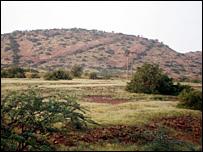 Vadodara,
Gujarat, India. August 6, 2006: Geologists have discovered a
striking archaeological feature on a hillock in the Kutch district
of the western Indian state of Gujarat. This feature is shaped like
the Roman numeral VI. Each arm of this feature is a trench that is
about two meters wide, two meters deep and more than 100 meters
long. The feature has evoked the curiosity of archaeologists because
such signs have mostly been observed so far in Peru. The team, led
by Dr RV Karanth, a former professor of geology at the Maharaja
Sayajirao University in Vadodara, Gujarat, has been involved in a
palaeoseismological study of the Kutch region for the past 11 years
Palaeoseismology involves the study of sediments, landforms and
other geological evidence of past earthquakes to unravel their
history and determine the nature and occurrence of present-day
earthquakes. This feature was discovered at a hillock 3km from the
sleepy oasis township of Khavda, which is also known as the gateway
to the Rann of Kutch, an extensive salt marsh of western India and
southeast Pakistan between the Gulf of Kutch and the Indus river
delta. Vadodara,
Gujarat, India. August 6, 2006: Geologists have discovered a
striking archaeological feature on a hillock in the Kutch district
of the western Indian state of Gujarat. This feature is shaped like
the Roman numeral VI. Each arm of this feature is a trench that is
about two meters wide, two meters deep and more than 100 meters
long. The feature has evoked the curiosity of archaeologists because
such signs have mostly been observed so far in Peru. The team, led
by Dr RV Karanth, a former professor of geology at the Maharaja
Sayajirao University in Vadodara, Gujarat, has been involved in a
palaeoseismological study of the Kutch region for the past 11 years
Palaeoseismology involves the study of sediments, landforms and
other geological evidence of past earthquakes to unravel their
history and determine the nature and occurrence of present-day
earthquakes. This feature was discovered at a hillock 3km from the
sleepy oasis township of Khavda, which is also known as the gateway
to the Rann of Kutch, an extensive salt marsh of western India and
southeast Pakistan between the Gulf of Kutch and the Indus river
delta.
Dr. Karanth says such trenches have not been noticed elsewhere in
the region. Archaeologists, he says, can now pursue further
research. Geometric lines and animal shapes etched into the desert
plain by people of the Nazca civilisation (AD 1-700) of Peru are
well known. "But such signs on hill-slopes have not been
reported from Peru," says Dr. Karanth. He says that one of the
prominent explanations given for the Peruvian features is that they
may have been constructed to make astronomical observations and
calculations. "The Tropic of Cancer
passes through Kutch. So if this structure is man-made, it is likely
that the slope of the hillock was utilized for making certain
astronomical calculations in the past," explains the
geologist. Interestingly, there are numerous indications to suggest
that Harappans were well-versed in astronomy. The straight streets
of that time were oriented in the cardinal directions - east, west,
north and south. Linkages between ancient Harappan scripts and
latter Vedic texts also suggest that Harappan priest-astronomers
tracked the progress of various planets and mapped the sky. Dr.
Karanth has also discovered ruins of a fort-wall, houses, storage
tank and a temple on the hilltop.
(source:
Large
Symbols Like Peruvian Signs Found on Gujarat Hillside -
bbcnews.co.uk).
The Find Includes Human Remains
Linda Moulton Howe, who investigates occurrences of this type
worldwide, interviewed Michael Cremo about this new discovery. Cremo
is a researcher and author of the book Forbidden Archaeology.
Cremo, Howe said, has visited India and attended local meetings
about the Cambay site.
"Within the past few months," Cremo told her, "the
engineers began some dredging operations there and they pulled up
human fossil bones, fossil wood, stone tools, pieces of pottery, and
many other things that indicated that it indeed was a human
habitation site that they had. And they were able to do more
intensive sonar work there and were able to identify more
structures. They appeared to have been laid out on the bank of a
river that had been flowing from the Indian subcontinent out into
that area."
According to Howe:
Even if we don't know what the
cultural background of the people is, if it does happen to be a city
that is 9500 years old, that is older than the Sumerian civilization
by several thousand years. It is older than the Egyptian, older than
the Chinese. So it would radically affect our whole picture of the
development of urban civilization on this planet.
Now, if it further happens that additional research is able to
identify the culture of the people who lived in that city that's now
underwater — if it turns out they are a Vedic people, which I
think is quite probable given the location of this off the coast of
India — I think that would radically change the whole picture of
Indian history which has basically been written by Western
archaeologists.
(source:
9,500-Year-Old
City Found Underwater Off India).
Indian civilisation '9,000 years old'
http://news.bbc.co.uk/hi/english/world/south_asia/newsid_1763000/1763950.stm
Marine
scientists in India say an archaeological site off India's western
coast may be up to 9,000 years old.
The revelation
comes about 18 months after acoustic images from the sea-bed
suggested the presence of built-up structures resembling the ancient
Harappan civilisation, which dates back around 4,000 years.
The Harappan
civilisation is the oldest in the subcontinent.
Although
Palaeolithic sites dating back around 20,000 years have been found
on the coast of India's western state of Gujarat before, this is the
first time there are indications of man-made structures as old as
9,500 years found deep beneath the sea surface.
Known as the
Gulf of Cambay, the area has been subject to a great deal of
archaeological interest due to its proximity
to another ancient submerged site - Dwaraka - in the
nearby Gulf of Kutch.
But
investigations in the Cambay region have been made more difficult by
strong tidal currents running at around two to three metres per
second.
They impede any
sustained underwater studies. Marine scientists led by the
Madras-based National Institute of Ocean Technology said they got
around this problem by taking acoustic images off the sea-bed and
using dredging equipment to extract artefacts.
Gulf of
Cambay has a city older than Sumer
http://www.indian-express.com/ie20020117/top6.html
Watch
video - The
Myth of Aryan invasion theory - Part I and Part
II and Part
III and Myth
of Aryan Dravidian Divide and Dwaraka
- A Lost City of Lord Sri Krishna.
Marine
archaeology and the study of the past
What
was found in the Gulf?
Several rectangular to round pieces made of rock and mortar with
perfectly shaped holes (some rectangular), obviously man-made; stone
cylindrical rods with vertical holes, probably used as necklaces (as
in Harappa); rolled rods and well-turned cylindrical rock pieces;
fused rock articles; thin triangular and round rock pieces; chert
blades, cut into long flat pieces; macro tools resembling axes,
stone blades, choppers, chisel, etc. and micro tools made of basalt,
chalcedony and chert, besides a pestle and fish hook; ladle-shaped
objects made of agate or steatite; semi-precious stones and beads
made of opal, agate, carnelian, steatite, quartz, malachite, and
topaz; potsherds, including sun-dried gray and kiln-baked red.
But these were not all. Human and animal (deer and duck) figurines,
a hand with what appears to be a carving of a bangle, a few
fossilised human bones and a flat rock piece with a sort of script
have made the finds more exciting.
Paleo channels 20 to 40 metres deep and over 9 kms long, adjoined by
basement-like features of major structures in a grid pattern,
resembling an urban habitation site, were observed. These include a
40m x 24m tank-like depression with steps leading to a deeper
portion (like the Great Bath of Mohenjo Daro?), a 200m x 45m
platform-like structure, a 79m x 50m buried structure and what
appears to be a 41m x 20m wall, with a relief of about 3m above the
seabed. Most important, a chunk of carbonised teak wood was picked
up, which was dated using 14C (Carbon dating) methodology by the
Birbal Sahni Institute of Paleo Botany, Lucknow, and the National
Geophysical Research Institute, Hyderabad, gave an interim
calibrated age of 8150-7650 BP (before present). This
is the information that came in for much public flak and acrimony,
with some historians and media stories even casting doubts on the
authenticity of the scientific testing and the results, an untenable
accusation. Foreign laboratories upheld the results, a certification
which should not have been necessary, and about which there has been
no response from the doubters.
Another reason given for doubt was that the wood could have floated
into the area from anywhere else. But the scientists present at the
workshop debunked that objection, showing how the current patterns
meant that the water circulates within the Gulf and is not exchanged
with the Arabian Sea.
Marine
archaeology in India is still at its infancy. It needs up-to-date
scientific equipment, such as remote controlled robots, and trained
divers and diving equipment. All this costs money.
(source:
Marine
archaeology and the study of the past - By Nanditha
Krishn - newindpress.com).
Aryan
Invasion Bites the Dust
In the rewriting of
Indian history that is currently underway, the Seminar on
Aryan/Non-Aryan Contributions held on June 23 – 25 at the Center
of Indic Studies, University of Massachusetts, Dartmouth is likely
to prove seminal. At the Seminar, now becoming known as the
Dartmouth Conference, advocates of the Aryan theories, including the
Aryan invasion, were forced to confront data from a wide range of
sources including historical, astronomical, genetic and
archaeological that simply could not be brushed away by appealing to
linguistics.
Most telling of all was the genetic evidence pointing to the fact
that Indians have lived where they are today for the better part of
50,000 years and no Aryan invasion took place. The genetic data was
presented by two leading workers in the field— Dr. Peter Underhill
of Stanford University and Dr. V.K. Kashyap of the National
Institute of Biologicals of New Delhi. Their findings overwhelmingly
contradict the notion of any Aryan invasion and/or migration for the
origin of Indian civilization.
Dr. B.B. Lal, India’s senior most
archaeologist, made a masterly presentation summarizing the whole
gamut of archaeological discoveries from the Sarasvati river to the
various Harappan sites pointing out how they bear the stamp of Vedic
ideas and thoroughly contradict the Aryan invasion. Rajaram
highlighted the fact that the Rigveda came before the Harappan
civilization, and Harappan archaeology belongs to later phase of the
Vedic civilization, the period that produced the Brahmanas,
Upanishads and the Sutras.
All this means that Harappan archaeology records the material
remains of the Vedic civilization, especial of the later phase, when
the ideas found the Veda Samhitas saw exposition, consolidation and
codification in the Vedantic literature. This is clear from the
Vedic symbols like the svastika, om, ashvattha leaves and others
found on Harappan artifacts especially the seals.
(source: Aryan
Invasion Bites the Dust - By N S Rajaram - saag.org).
No archaeological evidence to prove western invasion in the subcontinent:
Experts
NEW DELHI:
Having set the tone for a discussion on the roots of Indian civilization, the
seminar, “How deep are the roots of Indian civilization? An archaeological and
historical perspective”, brought up some pertinent questions related to the
subcontinent's past on Friday.
Day two of the
seminar organised by Draupadi Trust in
collaboration with the Ministry of Culture, the Indian
Council for Cultural Relations and the
Archaeological Survey of India was marked by inputs from renowned
archaeologists and scholars.
 In
the first session,
Omilos Meleton Cultural Institute
(Greece) director Prof. N. Kazanas spoke
about the “Collapse of the Aryan invasion theory”
based on linguistic evidence in the Rigveda supporting the indigenous nature of
Indian civilization and genetic evidence that there was “no influx of new genes
after 10000 B. C. in India”. In
the first session,
Omilos Meleton Cultural Institute
(Greece) director Prof. N. Kazanas spoke
about the “Collapse of the Aryan invasion theory”
based on linguistic evidence in the Rigveda supporting the indigenous nature of
Indian civilization and genetic evidence that there was “no influx of new genes
after 10000 B. C. in India”.
Prof. Kazanas'
presentation was followed by Case Western Reserve University Anthropology
professor Jim G. Shaffer, who spoke about the “Harappan diaspora”, explaining
how the increase in population density of Haryana and eastern Punjab and
decrease in population in Cholistan in the late Harappan period suggest a
“displacement from Harappan civilization towards the east”. He also said there
was no archaeological evidence to prove western invasion in the subcontinent.
Vedic scholar Dr. Bhagwan Singh spoke about
“Rigvedic Harappans: Their roots and legacy”, calling it “incorrect…to hold
Aryan-speaking branch to be the sole author of Indus-Sarasvati civilization”.
According to him, there were three major cultural strains- Aryan, Dravidian and
Mandari -- that cannot be classified into any one familial scheme.
Shah Abdul
Latif University (Pakistan) Vice-Chancellor Nilofar Shaikh presented recent
evidence found by the excavation of Lakahn-Jo- Daro site in Pakistan. The
architectural evidence at the site suggests a strong linkage to the “mature
Indus” civilization, in addition to some unique features like “I- shaped
bricks”.
Ms. Shaikh's
presentation was followed by Maharaja Sayajirao
University of Baroda's professor of Archaeology V.H. Sonawane's paper
on “The Harappan scenario in Gujarat”; Department of Archaeology and Museums
(Raipur) advisor Dr. A.K. Sharma's paper on “The Harappan Horse - A study in
comparative occurrence during Harappan & post Harappan times” and ASI (Nagpur)'s
Dr. Nadini Sahu's presentation on “Excavations at the Early Harappan site of
Bhirrana”.
The last
session included presentations by ASI secretary general K.N. Dikshit on “The
decline and legacy of Harappan civilization” and ASI joint director-general Dr.
B.R. Mani titled “From Janas to Janapadas”. The day concluded with BHU professor
Purushottam Singh who raised some important questions at the end of his
presentation on “Early archaeology in the Gangetic Plains”.
Prof. Singh
pointed out that the Ganga Valley civilization had no evidence of religion
except burial grounds found in some places. He also questioned the absence of a
“label” like the Aryans or Harappans for the people of this civilization, who
had contributed significantly to the history of the subcontinent.
(source:
No archaeological evidence to prove western
invasion in the subcontinent: Experts - hindu.com).
***
Lost city found off Indian coast
An ancient underwater city has been discovered off the coast of south-eastern
India. Divers from India
and England made the discovery based on the statements of local fishermen and
the old Indian legend of the Seven Pagodas.
The ruins, which are off the
coast of Mahabalipuram, cover many square
miles and seem to prove that a major city once stood there. A further expedition
to the region is now being arranged which will take place at the beginning of
2003.
(source:
Lost
city found off Indian coast
- BBC news.com April 11, 02).
Mahabalipuram remains open debate on origin of civilization
By
Shyam Bhatia - LONDON, Aug 15
This hidden underwater
city off Mahabalipuram in Tamil Nadu had previously been the stuff
of legend. Some fishermen had always spoken of the exotic temple
tops they had seen occasionally emerge from the sea, but few outside
their own small communities had taken serious note of their stories.
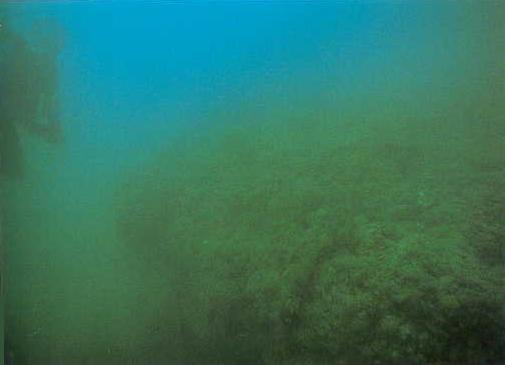
Side
wall of the U-shaped structure, Poompuhur, looming out of the murk.
The structure was submerged about 11,000 years ago.
Watch
video - The
Myth of Aryan invasion theory - Part I and Part
II and Part
III and Myth
of Aryan Dravidian Divide and Dwaraka
- A Lost City of Lord Sri Krishna.
Watch
Scientific
verification of Vedic knowledge
***
Now Graham Hancock’s discovery
earlier this year of a lost civilization that thrived some 30 miles
off the coast of Chennai is forcing scientists to revise their
theories and pay serious attention to his claim that civilization
did not start in Mesopotamia, but rather in cities like the
underwater Mahabalipuram that were drowned in floods at the end of
the last ice age between 7,000 and 20,000 years ago. A leading UK expert on
ice age sea levels has told him the site where he dived is indeed
some 6,000 years old.
“We can no longer think of the so-called
Fertile Crescent of Sumeria as the cradle of civilization”, says
Hancock. “What seems more likely from the large body of
evidence I have compiled is that there were a number of cities built
before this time which were submerged by rising sea levels at the
end of the last ice age. Mahabalipuram, I suspect, is one of
these.” The strongest evidence supporting his theory comes
from the Department of Geological Sciences at Durham University in
the UK where geo-physicist Dr Glenn Milne has built up a
sophisticated computer data base that prints out the images of
shorelines from any time in history.
After Hancock sent him his data from Mahabalipuram, Hancock told him
the site as at least 6,000 years old. “Assuming there was no
tectonic movement at the site, and it looks like there wasn’t,
then it appears that the area was flooded by a rise in sea levels
about 6,000 years ago”, Milne says. “The computer programme is
accurate to within 1,000 years either side of the allotted date.”
Hancock says Milne’s reaction has vindicated him. “It proved
that the methods I was using, the combination of deciphering ancient
myths and new technology, actually worked”, he argues. “Of
course I still keeping an open mind, but it does suggest I am on the
right track
after all. Its mainstream archaeology and science that are
blinkered.”
(source:
Deccan
Herald August 16' 02).
For more refer to
Underground:
The Mysterious Origins of Civilization – By Graham Hancock p.
374).
Structures
have also been found off the Poom Puhar coast, but South Indian
history is nothing more than a footnote in Indian history books. So
two major archaeological finds whimpered into oblivion after a few
magazine articles. Any other country would have celebrated them.
(source:
Marine
archaeology and the study of the past - By Nanditha
Krishn - newindpress.com).
City
Under the Sea
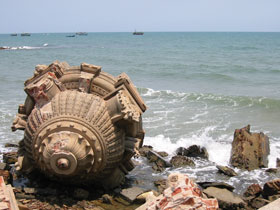 A
spectacular underwater archaeological find by a joint British-Indian
diving team that could rewrite history. Who
would have thought a city that could be older than the Harappan
civilization could be lying beneath water right off the coast of
Mahabalipuram? A
spectacular underwater archaeological find by a joint British-Indian
diving team that could rewrite history. Who
would have thought a city that could be older than the Harappan
civilization could be lying beneath water right off the coast of
Mahabalipuram?
Sometimes,
it pays to listen to the stories of humble fishermen. Local
fishermen in the coast of Mahabalipuram in Tamil Nadu have for
centuries believed in that a great flood consumed a city over 1,000
years ago in a single day when the gods grew jealous of its beauty.
The myths of Mahabalipuram were written down by British traveler J.
Goldingham,
who visited the town in 1798, at which time it was known to sailors
as the Seven Pagodas.
Legend had it that six temples were submerged
beneath the waves, with the seventh temple still standing on the
seashore.
(For
more information on this refer to http://www.india-atlantis.org/).
(source: City
Under the Sea http://india.krishna.org/Articles/2002/10/006.html).
Fossil
hints at India's mythical river
Geologists in
India say they have found an elephant fossil in the Thar desert of
Rajasthan, supporting earlier theories that the vast desert was once
a fertile area.
They said
the discovery also lent credence to popular belief that a mighty
river, named in the ancient Hindu Vedic texts as Saraswati, flowed
through the region thousands of years ago. The
significance of the river, mentioned in Vedic texts, is immense.
Senior geologist BS Paliwal said the
elephant fossil was discovered in a village in Nagaur district,
about 300 kilometres from the state capital of Jaipur, during gypsum
mining.
"It
proves again that there were once rivers like Saraswati and
civilisations were flourishing at their banks," Professor
Paliwal said.
Geologists had a few years ago found fossils of fish in Jaisalmer, a
district further west from the site of the present find. These
fossils were dated to be nearly 180 million years old. Geologists
said the find was evidence that large water bodies once existed in
the region.
(source: Fossil
hints at India's mythical river - BBC
December 2, 02).
Submerged
city may be older than Mesopotamia
There
is growing evidence that the East Coast of India was the real cradle
of modern civilization. Perhaps it's time to rewrite the history
books...?
A
submerged coastal city near Poompuhar
in Nagapattinam, Tamil Nadu,
is the focus of a major expedition being conducted jointly by the
Indian Naval Hydrographic Department (INHD) and the Archaeological
Survey of India (ASI).
Both
the organizations are trying to piece together the city's past,
which some noted marine archaeologists consider to be the birthplace
of modern civilization. The once flourishing port city is located
about one mile off the Nagapattinam coast.
"We
have been able to locate a section of the city at a depth of 7 m and
will soon start operations to recover objects that will help
ascertain its past," said Rear Admiral K.R. Srinivasan, chief
hydrographer to the Indian government. English
marine archaeologist Graham Hancock, who conducted an underwater
exploration in the area in 2001, believes that the Poompuhar
site could be older than Sumeria in Mesopotamia, where modern
civilization is believed to have originated nearly 5,000 years ago.
It
led Hancock to surmise that the city could have been submerged by a
tidal wave as high as 400 ft somewhere between 17,000 and 7,000
years ago.
(source:
Submerged
city may be older than Mesopotamia - By Utpal
Parashar
- hindustantimes.com).
Page < 1 2 3 4 5 6 7 8 9 10 11 12 13 14 15 >
|